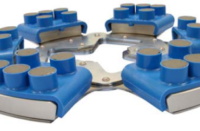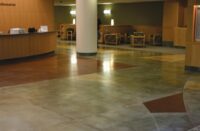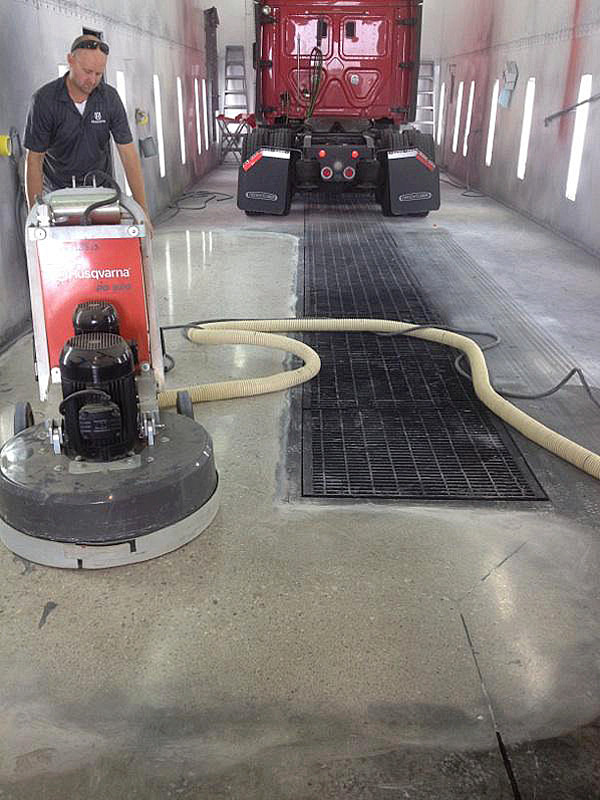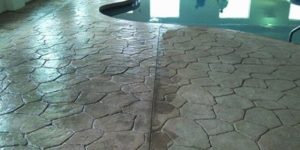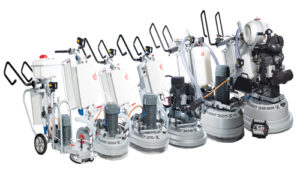Surface preparation is the crucial beginning stage of any concrete polishing process. It is especially important in old office buildings, warehouses or department stores where tile or carpeting once covered the flooring, leaving behind residue that must be removed before applying an overlay or polishing. Some of the major culprits include carpet glue, black mastic from VCT (vinyl composition tile), thin-set materials, epoxy coatings and rubber membranes, to name a few.
There are four main methods for addressing these residues: grinding, shotblasting, shaving, and buffing with a swing machine. Each has specific benefits and specialties.
Selecting the best method
Prior to determining which method most aptly suits a job, there are several factors to consider. However, keep in mind that there is not always a cut-and-dried solution. Every floor is different and brings with it unique difficulties.
A good place to begin is to assess the surface you are working on. Look at the type of residue that needs to be removed, the concrete hardness and the ultimate profile you desire. Typically, grinding is ideal for removing epoxies and glue. Shotblasting works well at cleaning off thin coatings and paint, shaving removes epoxies, mastics and paint, and buffing is preferred for glue and thin-set.
In addition, grinding and buffing with a swing machine achieves a smoother profile, whereas shotblasting and shaving may be a tad rougher.
Next, look at the size and nature of the job. For a greater square footage, a grinder or shotblaster is ideal because either can cover more surface area. Buffing with one swing machine is perfect for smaller jobs, while a larger area can be covered with four or five machines.
For a job that first requires a concrete overlay application, shotblasting and shaving may be ideal, whereas grinding is the best alternative for a purely polished concrete job.
Another factor is cost, or how much you wish to spend on surface preparation. Inevitably you have a set budget, so for the most economical approach, buffing with a swing machine is common. Grinding and shaving can be more costly because of the diamonds that accompany them, and shotblasting costs somewhere in between.
Finally, browse the equipment you already own, and work with what you have to eliminate costs and procurement. For instance, if you already own an industrial floor grinder, use it when necessary.
When to switch up grinding tooling
Grinding removes almost any coating or mastic that plagues your floor, but there are three main tooling options to choose from. Each addresses certain residues.
Conventional segments, or metal-bonded diamonds, remove brittle adhesives really well. Apply play sand, dust or portland cement to your surface and grind with 16-to-25-grit metal bonds. The sand will attach to the adhesive and pull it up in small balls, all while keeping the diamonds clean.
The second option is carbides, which remove tacky adhesives such as carpet glue. Carbides act like a ride-on scraper would for removal, and they don’t gum up like metal segments would with tacky glue. Another benefit of carbides is that they leave a smooth finish, not damaging the concrete at all. Lastly, carbides cover a large surface area.
PCD (polycrystalline diamond) tooling is the best option for removing epoxy coatings, adhesives, leveling compounds or membranes. PCDs’ specialties are thicker residues or high-build coatings. PCDs are popular because they are so aggressive, ideal for 1/8-inch, 3/16-inch or greater thicknesses.
Why shotblasting is popular
Shotblasting cleans and profiles a surface simultaneously. It strips off thin coatings well. Depending on how powerful and aggressive the machine is, it may remove glue or mastics as well, but typically, if the coating does not allow rebound, a shotblaster will not work.
Shotblasting is popular because it delivers high production rates and is dust-free, dry and cost-effective. It is also known for blast pattern accuracy and a wide abrasive selection. However, keep in mind that shotblasting can weaken a concrete surface or make it uneven, which is why it is more suited for profiling before applying an overlay, as opposed to before polishing.
The benefits of shaving
As stated, shaving is the ideal option for removing epoxies, mastics or paint. Shaving is used for uneven concrete and residue removal because it works quickly and makes corrections simple. Also, if you need to take up a concrete overlay that failed, shaving is a good alternative.
Shaving creates evenly spaced grooves to provide traction and reduce slips and falls, as well as leveling and flattening the surface. With this said, shaving is the best method for a floor with dual problems: residue buildup and an unleveled or bumpy surface. Not to mention, if a job also requires you to create a trench or trough, shaving can cut deeper in one pass, actually making it a three-in-one solution.
Economical buffing
The final method for removal is buffing with a swing machine. Buffing with a swing machine removes glue and thin-set, and it floats easily over rough surfaces. For removal we suggest using a 17-inch hex pin head, but you can also opt for a heavy-duty wire brush. Remember though, buffing with a swing machine is not as effective as a heavy-duty grinder for tough glue, especially on a large surface. This method is economical and best suited for smaller jobs. It can be an adequate substitute if, for instance, a contractor doesn’t own a large grinder and has a small area of glue that needs to be removed.
The future of surface preparation
Surface prep is growing in popularity and quickly becoming its own specialty within the realm of concrete polishing. In fact, we have several contracting customers that exclusively perform surface preparation. They are hired to do all the prep work on a concrete surface, and then another contractor will finish it off with overlay or polishing work.
Understanding all of these methods can become convoluted with such a myriad of factors and options, but this is not an exact science. Although each method has preferred applications and benefits, there isn’t one right or wrong answer, so use these tips as a set of guidelines rather than set-in-stone rules.
